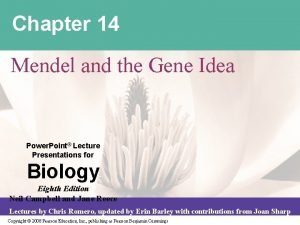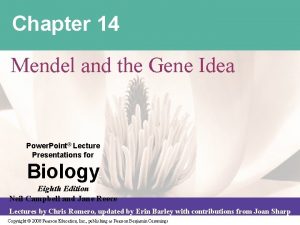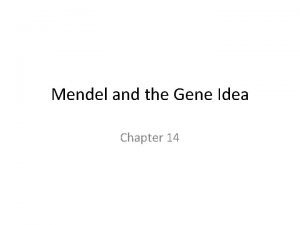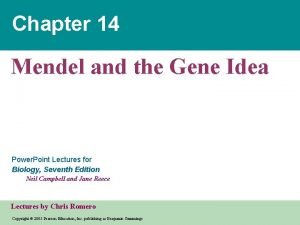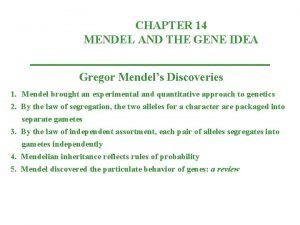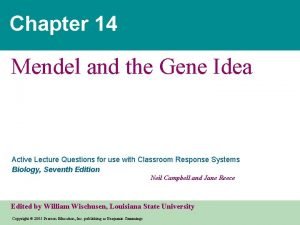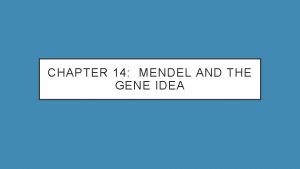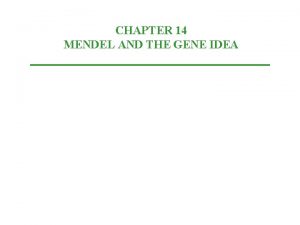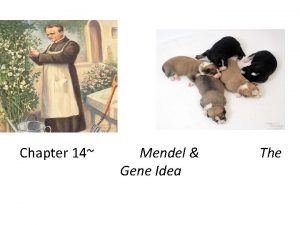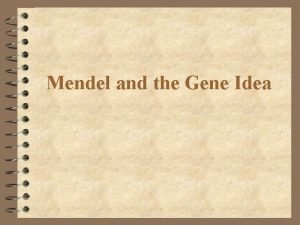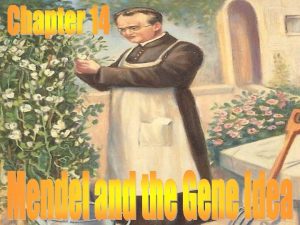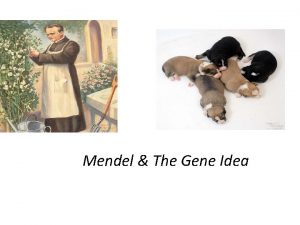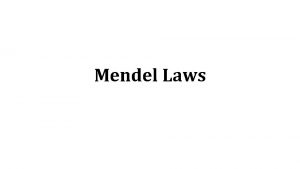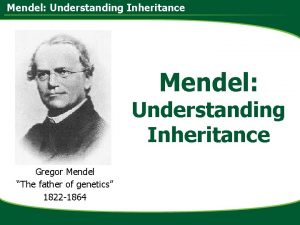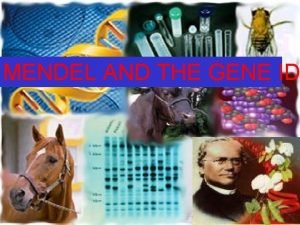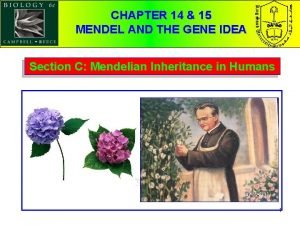Chapter 14 Mendel and the Gene Idea Active













- Slides: 13

Chapter 14 Mendel and the Gene Idea Active Lecture Questions for use with Classroom Response Systems Biology, Seventh Edition Neil Campbell and Jane Reece Edited by William Wischusen, Louisiana State University Copyright © 2005 Pearson Education, Inc. publishing as Benjamin Cummings

1. A couple who are both carriers of the gene for cystic fibrosis have two children who have cystic fibrosis. What is the probability that their next child will have cystic fibrosis? 1) 0% 2) 25% 3) 50% 4) 75% 5) 100% Copyright © 2005 Pearson Education, Inc. publishing as Benjamin Cummings

1. A couple who are both carriers of the gene for cystic fibrosis have two children who have cystic fibrosis. What is the probability that their next child will be phenotypically normal? 1) 0% 2) 25% 3) 50% 4) 75% 5) 100% Copyright © 2005 Pearson Education, Inc. publishing as Benjamin Cummings

3. In cattle, roan coat color (mixed red and white hairs) occurs in the heterozygous (Rr) offspring of red (RR) and white (rr) homozygotes. When two roan cattle are crossed, the phenotypes of the progeny are found to be in the ratio of 1 red: 2 roan: 1 white. Which of the following crosses could produce the highest percentage of roan cattle? * a) red white b) roan c) white roan d) red roan e) All of the above crosses would give the same percentage of roan. Copyright © 2005 Pearson Education, Inc. publishing as Benjamin Cummings

1. What is the probability that individual C-1 is Ww? 1) 3/4 2) 1/4 3) 2/4 4) 2/3 5) 1 Copyright © 2005 Pearson Education, Inc. publishing as Benjamin Cummings

1. A woman and her spouse both show the normal phenotype for pigmentation, but both had one parent who was an albino. Albinism is an autosomal recessive trait. If their first two children have normal pigmentation, what is the probability that their third child will be an albino? 1) 0 2) 1/4 3) 1/2 4) 3/4 5) 1 Copyright © 2005 Pearson Education, Inc. publishing as Benjamin Cummings

1. In a cross Aa. Bb. Cc, what is the probability of producing the genotype AABBCC? 1) 1/4 2) 1/8 3) 1/16 4) 1/32 5) 1/64 Copyright © 2005 Pearson Education, Inc. publishing as Benjamin Cummings

1. Feather color in budgies is determined by two different genes that affect the pigmentation of the outer feather and its core. Y_B_ is green; yy. B_ is blue; Y_bb is yellow; and yybb is white. A green budgie is crossed with a blue budgie. Which of the following results is not possible? a) all green offspring b) all blue offspring c) all white offspring d) all yellow offspring e) All of the above are possible, but with different probabilities. Copyright © 2005 Pearson Education, Inc. publishing as Benjamin Cummings

8. Three babies were recently mixed up in a hospital. After consideration of the data below, which of the following represent the correct baby/parent combinations? Couple # Blood groups I A and A II A and B III B and O Baby # Blood groups 1 B 2 O 3 AB a) I-3, II-1, III-2 b) I-1, II-3, III-2 c) I-2, II-3, III-1 d) I-2, II-1, III-3 e) I-3, II-2, III-1 Copyright © 2005 Pearson Education, Inc. publishing as Benjamin Cummings

9. A man is brought to court in a paternity case. He has blood type B, Rh positive. The mother has blood type B, Rh negative. Which blood type of a child would exclude the accused from paternity? a) AB, Rh negative b) B, Rh negative c) O, Rh negative d) B, Rh positive e) None of these choices will exclude. Copyright © 2005 Pearson Education, Inc. publishing as Benjamin Cummings

1. You are handed a “mystery’’ pea plant with long stems and axial flowers, and asked to determine its genotype as quickly as possible. You know the allele for long stems (L) is dominant to that for dwarf stems (l) and that the allele for axial flowers (A) is dominant to that for terminal flowers (a). You cross the “mystery” plant with a dwarf stemmed axial flowered plant. If your mystery plant is heterozygous at both loci, what is/are the expected proportion of offspring? 1) 100% long stemmed terminal flowered 2) 100% dwarf stemmed terminal flowered 3) 100% long stemmed axial flowered 4) 50% long stemmed axial flowered, 50% dwarf stemmed terminal flowered 5) 25% long stemmed axial flowered, 25% long stemmed terminal flowered, 25% dwarf stemmed axial flowered, 25% dwarf stemmed terminal flowered Copyright © 2005 Pearson Education, Inc. publishing as Benjamin Cummings

11. You think that two alleles for coat color in mice show incomplete dominance. What is the best and simplest cross to perform in order to support your hypothesis? a) a testcross of a homozygous recessive mouse with a mouse of unknown genotype b) a cross of F 1 mice to look for a 1: 2: 1 ratio in the offspring c) a reciprocal cross in which the sex of the mice of each coat color is reversed d) a cross of two true-breeding mice of different colors to look for an intermediate phenotype in the F 1 e) a cross of F 1 mice to look for a 9: 7 ratio in the offspring Copyright © 2005 Pearson Education, Inc. publishing as Benjamin Cummings

12. A mother with type B blood has two children, one with type A blood and one with type O blood. Her husband has type O blood. Which of the following could you conclude from this information? a) The husband could not have fathered either child. b) The husband could have fathered both children. c) The husband must be the father of the child with type O blood and could be the father of the type A child. d) The husband could be the father of the child with type O blood, but not the type A child. e) Neither the mother nor the husband could be the biological parent of the type A child. Copyright © 2005 Pearson Education, Inc. publishing as Benjamin Cummings
 Mendel and the gene idea chapter 14
Mendel and the gene idea chapter 14 Chapter 14 mendel and the gene idea
Chapter 14 mendel and the gene idea Chapter 14 mendel and the gene idea
Chapter 14 mendel and the gene idea Chapter 14: mendel and the gene idea
Chapter 14: mendel and the gene idea Chapter 14 mendel and the gene idea
Chapter 14 mendel and the gene idea Chapter 14 mendel and the gene idea
Chapter 14 mendel and the gene idea Chapter 17 gene expression from gene to protein
Chapter 17 gene expression from gene to protein Gene by gene test results
Gene by gene test results Define central idea
Define central idea Contoh topik dan controlling idea
Contoh topik dan controlling idea Idea subject
Idea subject Topic sentence and supporting sentence
Topic sentence and supporting sentence What is the central idea of this passage?
What is the central idea of this passage? And or boolean
And or boolean
